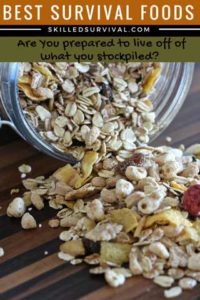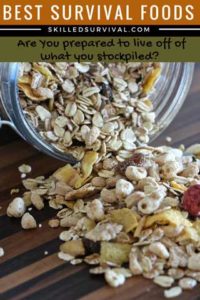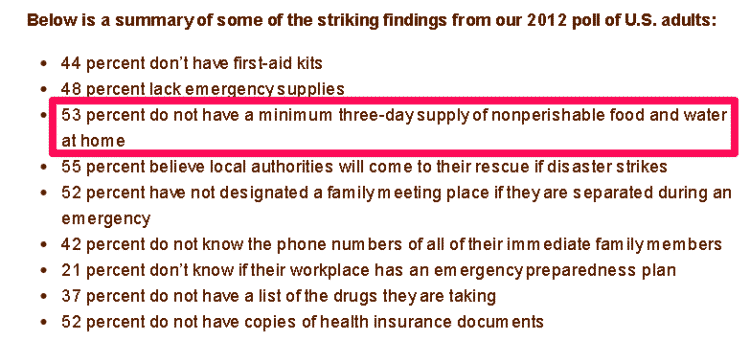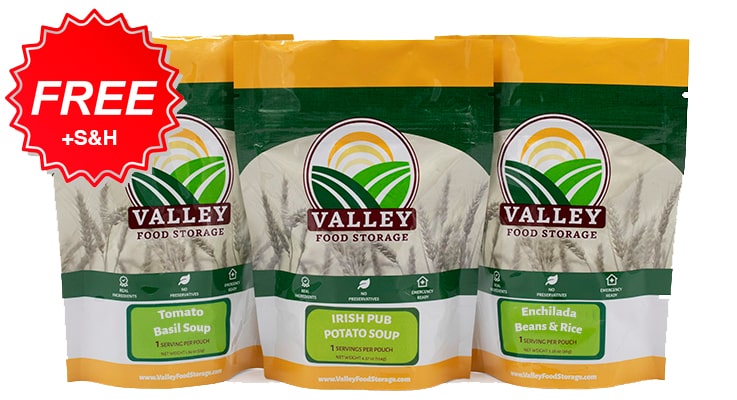
Hurricanes and winter storms are rarely a surprise but is anyone listening?
It’s a shocking stat but 53% of US households don’t have a three-day supply of nonperishable food.
53% is barely over half.
If that number doesn’t scare you, I don’t know what will.
In times of crisis, nearly half the population would begin to starve before the end of a single week.
The key here is non-perishable food items. If you inventoried your food right now you’d realize pickles and frozen, uncooked, burgers won’t work in this type of emergency.
You might intend to rush to the store after work, but by then it’s too late.
The milk, peanut butter, and bread are gone, as well as the candles and camping stoves.
That’s the problem with trying to get your hands on the best survival foods once an emergency has arrived. Not to mention all the emergencies that occur without advanced warnings.
What happens after a nuclear strike or an EMP blast?
You get to live off of what you stockpiled ahead of time and by the looks of the statistics, there’s going to be a whole lot of hungry people after just a few short days.
A large part of the survival puzzle is the type of food you want to store.
The rest of the solution resides in getting the food now (before it’s too late) and finally how you will prepare the food with limited resources.
You need to prepare long before the actual emergency is broadcast to the public.
By then, even with money in hand, the best foods will be gone.
Should you manage to get past these hurdles, you will still need a diet that can provide a sufficient number of calories with the right nutritional value to keep you healthy in a long-term emergency.
As A Way To Introduce You To Skilled Survival, We’re Giving Away Our #78 Item Complete Prepper Checklist. Click Here To Get Your FREE Copy Of It.
Best Survival Foods Criteria
If you’re ever in a situation without electricity, you’ll need foods you can cook using survival methods. Your fancy electric range will be out of commission.
For a snowstorm emergency maybe the electricity remains, but you lose access to a grocery store.
Every survival situation is unique.
Massive floods will ruin unprotected foods due to contaminated waters.
Hopefully, you keep your bulk-dried food items in watertight sealed 5-gallon containers.
Some crises might require a bug out escape carrying very few staples. Ones that are not too heavy to carry.
You can’t totally prepare for every possibility, but there are some best practices for stockpiling the best emergency foods.
Foods You Love To Eat
Eating the same thing day in and day out will get boring. You should include a variety of foods you eat every day. There’s a reason we call these “comfort foods”.
It’s those foods that make us smile and bring joy even in times of trouble.
If you love butter, get a #10 can of butter powder. If you love cheese, go for a #10 can of freeze-dried mozzarella cheese.
It’s not only yummy, but it can provide needed fats and calories on an otherwise bland diet.
Don’t just stock items you never eat or don’t know how to prepare because a SHTF scenario is not the time to get creative with your cooking skills.
Long-Lasting Foods
If you’re stockpiling foods before a crisis, it may be months or years before you use them. You can rotate your pantry, but there will always be some foods that will take longer to use than others.
Most preppers take this fact into consideration by opting for foods that are preserved in cans, freeze-dried meals, or simply have a long shelf-life.
The best survival foods last at least one year without refrigeration or are eaten and rotated out before then.
Or you can invest in long-lasting high-quality freeze-dried food from Valley Food Storage, Legacy Food Storage, or Wise Emergency Food.
Note: If you’re serious about investing in some freeze-dried survival food kits, make sure to read our survival food reviews: Valley Food Storage review, Legacy Emergency Food Review, and Mountain House Review before you buy.
While supplies last, you can get a FREE 3-pack of survival food from Valley Food Storage (+S&H).
This 3-pack sells on their website every day for $60.00.
Getting it here for only S&H is a steal of a deal.
Don’t delay, claim your FREE 3-pack of survival food right now (+S&H).
As A Way To Introduce You To Skilled Survival, We’re Giving Away Our Family First Food Planning Guide. Click Here To Get Your FREE Copy Of It.
Nutritionally-Dense Foods
Beans and rice may not be a part of your best emergency foods strategy, but they are long-lasting foods that provide a complete protein when combined.
Beans and rice may not be a part of your best emergency foods strategy, but they are long-lasting foods that provide a complete protein when combined.
You can opt for different types of legumes that you might like better or find easier to digest than pinto beans, like garbanzos, red kidney beans, or lentils.
Augason Farms has a large selection of survival beans.
Flexible Foods
The best survival foods offer your diet some flexibility which is a good way to keep it from getting boring.
Dried powdered milk may not be something that will keep you satisfied on its own, but it can be used to create yogurt, cheese, puddings, and bread.
Foods that have some trading value can also be used in your own recipes and as barter for when you get tired of eating out of your own stock.
Foods You Don’t Have To Cook
You can include some foods that require some processing before eating, like red wheat berries, but ultimately, in the first few days don’t expect to do much cooking.
You will need ready-to-eat foods.
The electricity grid might be down and/or you might also have to leave the area. If you’re on the road, you won’t have time to create a fire and cook.
Plan to have quite a number of lightweight food sources that do not require heat, like military MRE meals, they are some of the best survival foods in your pantry.
As A Way To Introduce You To Skilled Survival, We’re Giving Away Our Family First Food Planning Guide. Click Here To Get Your FREE Copy Of It.
Basic Survival Food Groups
With these criteria in mind, let’s take a look at some of the choices you might opt to add to your best survival foods emergency pantry.
Remember that you will need to store these items in bulk.
You will also need to buy additional non-food items to make sure you can prepare the foods, should your emergency situation drag on past the ready-to-eat meals, like wheat grinders.
Create a balanced diet that is nutritionally dense, easy to store long-term, and tasty.
1. Drinks
Bottled water will be the most important food to add to your emergency pantry. You won’t be able to survive more than 3 days without potable drinking water.
However, you can also add calorie-rich powdered drink mixes that will create milk, vitamin-rich waters, or just flavored treats.
Even including Tang orange drink can be a way to get 100% of the RDA of vitamin C in your diet in an emergency situation.
Plus, it just tastes good.
These items are lightweight and also have a trading value. They can also double as medicinal supplies if you include teas and vitamin-powdered drinks.
2. Meat
Meat is the hardest item on your emergency list because it will have to be ready to eat. You can’t store butchered meat for long and you will be expected to hunt for food at some point.
You can store ready-to-eat canned meats like spam, ham, and chili, and they will make a satisfying meal. However, they won’t travel well, should you need to leave the area.
Some people solve the meat problem by raising chickens, rabbits, and goats and installing aquaponics systems as ready sources of meat for long-term uses. However, you’ll want a good supply of freeze-dried meat packages too.
You can get freeze-dried chicken or beef that some companies claim has a 25-year shelf life. You will need to rehydrate this, but that’s easily done when you toss them into another recipe.
One of my favorite ways to stockpile meat is by making pemmican.
It’s a way you process meat into dried bars that can last at least 50 years if processed and stored correctly.
3. Fish
One overlooked source of essential protein is canned fish.
You can eat tuna, sardines, and herring straight out of the can, and are all super-rich in nutrients. However, I get it, not everyone gets excited about snacking on fish in a can.
But listen, in a starvation situation that picky attitude will quickly change. After about 4 days of starvation, it’ll become one of the most delicious dishes you’ve ever had.
Plus, these are survival food items that you can stock up even on a limited budget.
4. Dairy
You can freeze some cheeses, however, if your power goes out, so will your frozen food stockpile. That makes dairy one of the hardest food groups to include in your emergency foods pantry.
Learn how to make your own cheeses and yogurts with dried milk.
Own a goat.
Buy canned cheese, but be aware that this may be the first item to disappear off your shelf when people get hungry.
As A Way To Introduce You To Skilled Survival, We’re Giving Away Our Family First Food Planning Guide. Click Here To Get Your FREE Copy Of It.
5. Grains, Nuts, and Legumes
Grains, nuts, and legumes, when put together produce a complete protein similar to meat and dairy. They tend to also come in dried forms that store well.
If you store red wheat berries, they can be ground up and made into bread. Combine that with nuts or legumes and you have a complete protein. You can get very creative in this area.
You can also use a hardtack recipe to make a basic survival cracker that can last decades if stored properly.
Pasta and beans comprise a complete protein and both have a long-term shelf life and make some of the best survival foods that are also cheap to buy in large quantities.
Use peanut butter instead of raw nuts to make a complete protein with crackers, and they don’t have to be heated to enjoy.
It’s not all about rice and beans.
Don’t forget to include grains, nuts, and beans that you can sprout for additional nutrition, like wheat berries, sunflower seeds, and garbanzo beans.
These can provide needed greens in a situation where you might have low-light growing conditions.
6. Fruits and Veggies
Dehydrated fruits are easy and lightweight to store.
They can be tossed into a variety of recipes to create diversity in the diet and are nutrient-rich, too.
They can be used in recipes when you’re not in an emergency situation, too, and rotated out.
Combine them with grains and nuts for quick foods that don’t require heating to be served.
Most preppers will assume that they won’t be storing too much of these and instead be focusing on the seeds to grow these in their garden to supplement their other emergency preps.
However, there’s no reason you can’t start your fruit and vegetable stocks now.
7. Oils
Oils are required to keep the body healthy and cook food.
Sweeteners, spices, and alcohol are not necessary or nutritional but can help you season foods that may not otherwise be palatable.
Are they non-essential? It depends on who you ask.
Pick an oil that you enjoy that has a long life and doesn’t go rancid. Canned butter has a shelf life that exceeds a year.
Extra virgin coconut oil has a shelf life of at least 7 years to 15 years.
It’s one oil that should be considered for its high nutritional value as well as its ability to be solid at room temperature. It has both antifungal and antibacterial properties.
Melts with the warmth of your hand and it can work double-duty as a hair conditioner, hand cream, and salve.
However, if you’ve never cooked with coconut oil or used it, you’ll need to experiment before the actual emergency happens, or it won’t do you much good.
If Crisco is something you’re more familiar with, stock up on that. It won’t be as nutritionally dense, but it won’t go to waste either.
8. Sweeteners
Honey is another sweetener that can be stored long-term and has medicinal value.
Some say honey never goes bad, although that may be hard to prove.
For those that prefer something that is not in liquid form, you can store white sugar, which is also said to last indefinitely.
You can use either to preserve foods like wild fruits and berries as well as roots.
9. Spices
Salt was once a trading spice, and can come back again should the SHTF.
It is valuable for making food flavorful and for preserving food.
However, other spices that meet the same criteria are seasoning packets that are cheap to buy and won’t be available at an open grocery store during an emergency.
10. Alcohol
What alcohol might make it into your survival foods pantry?
Don’t go for the flavored liquors and wine.
Instead, focus on distilled spirits that can be used in medicinal applications (sterilize a wound) and can also be used to preserve other foods, like fruits.
Good choices are vodka, rum, and whiskey.
If you learn how to make moonshine or how to ferment foods into alcoholic wines and beers, you will have a skill in demand after the SHTF.
Frozen Food Is Not The Solution
Prepared survivalists who think they’ll be sitting pretty while their neighbors starve because they have a freezer stocked with game, cheese, and food are going to be bitterly disappointed if the power goes out for periods of time.
However, if they’re trying to figure out whether to use that generator to keep their refrigerator and microwave on to defrost food, instead of keeping warm, they’ll soon figure out that keeping warm and dry will take precedence.
Building a pantry that includes the best survival foods is not the same as randomly hoarding food.
It requires a thoughtful approach. It’s key to surviving when modern conveniences are stripped away and you’re left on your own.
Remember: Prepare, Adapt and Overcome,
“Just In Case” Jack
P.s. Are you ready for the tough times ahead?
Find out now by taking my short Readiness Score Quiz – it’s absolutely free.
Once complete, you’ll know exactly where you stand on the “fragile” vs.” resilient” spectrum.
So click here to start the Quiz….And don’t worry; the questions are so easy a 3rd grader could answer them.
Click on the image to begin the Quiz and find out once and for all if you’re part of “The Fragile Masses” or “The Resilient Few.”
The post Best Survival Foods: The Must Have Non-Perishables appeared first on Skilled Survival.





